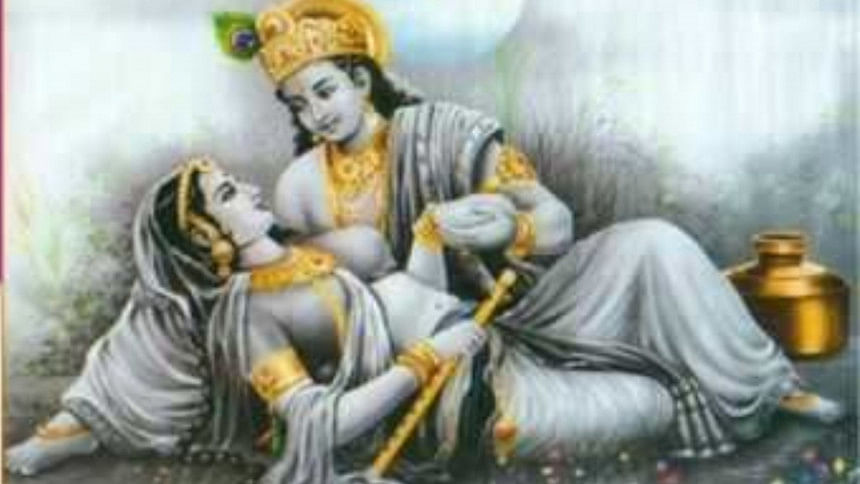Some Issues in Medieval Bangla Literature: Baru Chandidas and Vidyapati

1
It is undoubtedly a challenging task to characterize the world of medieval Bangla literature, given its rich diversity and staggering magnitude. That very world not only spans nearly six hundred years from 1200 to 1800 but also provides impressive and massive constellations of texts, trends, or tendencies—both conflictual and converging. Yet one might roughly say that medieval Bangla literature may be represented by such cultural productions as the Mangalkavyas, literatures-in-translation, the Vaishnava Padavali, biographies, nathshahitya, romance literature, and folk narratives, to mention but a few. But they are all in verses. Indeed, the very history of Bangla literature from its early period—from the eighth century to the end of the eighteenth century--is the history of verses alone, broadly speaking.
And the entire range of versifying or discursive practices during the medieval era certainly resists any quick cataloguing. Yet one might readily begin by mentioning Baru Chandidas's Sri Krishnakirtan—a work that marks a particular height of poetic achievement since the earliest Bangla literary work called the Charyapada, a collection of padas or lyrics, produced during a period between 950 and 1200. As a fact, it is interesting that Sri Basantaranjan Roy Vidyadallavya discovered the manuscript of Baru Chandidas's Sri Krishnakirtan in a cow-shed of a poor peasant from Bankura.
Put categorically, Sri Krishnakirtan—divided as it is into thirteen parts—offers a sustained narrative, if not a strict Bildungsroman, of the birth and growth of Krishna as well as his love-life. We know that Krishna is a Hindu deity worshipped in a number of ways in different theological traditions; that the earliest text that provides an attractive, occasionally even a grand, portrait of Krishna is the Mahabharata itself, an epic that depicts him as the decisive incarnation of none other than Vishnu. Also, of course, Krishna is reckoned as the Supreme God by the Vaishnava schools, while a special brand of Vaishnavism—called the Gaudiya Vaishnavism—treats Krishna as the source of all other avatars, including even Vishnu himself.
But Sri Krishnakirtan makes use of popular stories surrounding Krishna and his lover Radha. Thus, the work de-emphasizes strict theological or mythological accounts of Krishna and Radha as the supreme symbols of the Paramatman—the Absolute as such. In other words, Baru Chandidas's work undercuts theocentrism—the religious practice of centering God—while accentuating and foregrounding anthropocentrism, the practice of centering humans themselves in their own worldly settings and relationships.
Baru Chandidas even goes to the extent of decentering and de-mythologizing the very figure of Krishna—otherwise inordinately canonized in the theological tradition—while re-creating the character of Radha as a forceful, glorious, attractive, noble, loving one—a figure that even strikes us as running counter to an arrogant, lustful, vindictive, or vengeful Krishna. Baru Chandidas, thus, does not leave us with the impression that the relationship between Radha and Krishna is simply comedic or conventional in character. That relationship is rather a troubled one—a relationship that falters, flounders, and yet opens up spaces of promises and possibilities. Put another way, that relationship is not in a state of being but in a process of becoming.
And to submit that Sri Krishnakirtan is a verse-narrative is by no means sufficient. True, this work exemplarily inaugurates a particular narrative tradition in Bangla literature. And, true, Baru Chandidas offers superb examples of what might be called narrative engineering. But if one has to characterize his work more accurately, one needs to see how that work combines, enacts, interconnects, mobilizes—as it surely does—the narrative and the lyrical and the dramatic all at once. In fact, they all come to characterize medieval Bangla literature as a whole. Further, we see during the Middle Ages numerous signifying practices that privilege theocentrism, zeroing in on certain mythological gods and goddesses. We also see many other practices that come to valorize anthropocentrism itself. Baru Chandidas combines all of this with such force and effects that his Sri Krishnakirtan can be safely regarded as one of the true representative works of medieval Bangla literature.
2
As was indicated, the sheer magnitude of Bangla literary production during the Middle Ages is overwhelming. And I can only provide a quick, extremely inadequate, and tentative list of works here.
Of course, there is first this remarkable, massive Mongolkavyadhara—one that is constituted by such narratives as Manasamongol, Chandimongol, Dhramamongol, Durgamongol, Sivamongol, Kalikamongol, and so on. We have then impressive works of translation such as Krittyibas's translation of the Ramayana, Kasiram Das's translation of the Mahabharata, and Maladhar Basu's translation of the Bhagavata, among many others. Then there are massive works of romance literature produced by such poets as Shah Muhammad Sagir, Jainuddin, Sabirid Khan, Chand Kazi, Abdul Hakim, and certainly Syed Alaol. And Alaol is regarded as one of the most powerful medieval Bengali poets.
But any account of medieval Bangla poetry remains profoundly insufficient and even thoroughly misleading without mentioning the famous and influential Vaishnava Padavali produced by a whole host of lyrically engaged and erotically charged poets such as Vidyapati, Chandidas, Gyanadas, Govindadas, Lochondas, Roy Shekhar, Norrottyam, Ananta Das, Balaram Das, Kaviballava, to name but a few.
We have also remarkable evidence of Vaishnava biographical literature; the remarkable constellation of Baul-Murshidi-Marufati songs; the Shakta musical compositions; the Vidyasundarkavya, and the famous Kavigaan movement represented by the songs of Haru Thakur, Ram Basu, Nidhu Babu, Rupchand Pakshmi, Dashu Roy, Madhukan, Gopal Ure, and so on.
Now let me turn to one of my most favorite medieval Vaishnava Padavali poets—Vidyapati (1352 or 1374—1448).
Vidyapati was born in the village of Bisapi in Madhubani, on the eastern side of north Bihar, India. Courtier and scholar, Vidyapati, though a Bengali poet, is primarily known for his love-lyrics composed in a language called Brajabuli—a language consisting of Hindi and Prakrita and certainly Bangla words. In the well-known tradition of the Kama Sutra and the influential Gita Govinda by Jayadeva, Vidyapati's love-songs re-create and reveal the world of Radha and Krishna. Such poems convey the devotion of Krishna's worshippers through the metaphor of human erotic love. And Vidyapati excels in mobilizing metaphor after metaphor with some kind of tropological delirium, fashioning a poetics predicated on the privileging of the metaphorical over the literal—a poetics pressed into the service of the lover of course.
While Jayadeva celebrates Krishna's love and pays comparatively little attention to Radha as a woman, Vidyapati is primarily concerned with the intense passion of Radha's love. At once sensuous and sensual, descriptive and dramatic, Vidyapati's songs range beyond the mythological only to find their place in the heart of a human lover whose dreams and desires never die, whose sighs and cries never end.
Let's then take up a lyric by Vidyapati, a poem in which Krishna expresses his devotion to Radha, his principal consort. Bites and fingernail-marks constitute a particular semiotic performance—so to speak—of passions in certain Vaishnava lyrics. The language there is one of erotic violence, released as it is to express the power of the union between worshipper and god; but note how the god plays the submissive role in the following poem, almost as if he were worshipping the human woman:
For heaven's sake, listen, listen, O my darling:
Do not dart your cruel, angry glances at me,
For I swear by the lovely pitchers of your breasts,
And by your golden, glittering, serpentine necklace:
If ever on earth I dare touch anyone except you,
Let your necklace turn into a real snake, and bite me;
And if ever my promise and words prove false,
Chastise me, O darling, in the way you want to.
But, now, don't hesitate to take me in your arms,
Bind, bind my thirsty body with yours; bruise me
With your thighs, and bite, bite me with your teeth.
Let your fingernails dig deep, deep into my skin!
Strangle me, for heaven's sake, with your breasts,
And lock me in the prison of your body forever!
Now we have another lyric by Vidyapati. We know that Krishna is a playful god, associated with tricks and games. In one of the most famous incidents in the Krishna legend, he steals the clothing of a group of bathing cowherds' wives—gopis as they are called—and exhorts them to come forth from the water to reveal themselves. The religious significance of this incident is that the believer must not hold back from uniting fully with the divine, must be utterly devoted to the god. Similar attitudes are expressed in the following poem in relation to Radha:
All my inhibition left me in a flash,
When he robbed me of my clothes,
But his body became my new dress.
Like a bee hovering on a lotus leaf
He was there in my night, on me!
True, the god of love never hesitates!
He is free and determined like a bird
Winging toward the clouds it loves.
Yet I remember the mad tricks he played,
My heart restlessly burning with desire
Was yet filled with fear!
Now the last poem, one in which Radha has to deal with her jealousy. Krishna is the lover of all women (representing all humanity with a certain male chauvinism, as some feminist readings of Vidyapati suggest), and she cannot hope to keep him to herself:
He promised he'd return tomorrow.
And I wrote everywhere on my floor:
'Tomorrow.'
The morning broke, when they all asked:
Now tell us, when will your 'Tomorrow' come?
Tomorrow, Tomorrow, where are you?
I cried and cried, but my Tomorrow never returned!
Vidyapati says: O listen, dear!
Your Tomorrow became a today
with other women.
Azfar Hussain teaches in the Integrative, Religious, and Intercultural Studies Department within the Brooks College of Interdisciplinary Studies, Grand Valley State University in Michigan, and is Vice-President of the Global Center for Advanced Studies, New York, USA.

 For all latest news, follow The Daily Star's Google News channel.
For all latest news, follow The Daily Star's Google News channel. 



Comments